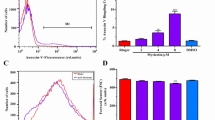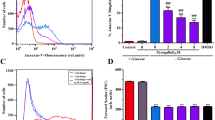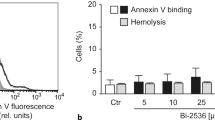Abstract
Phenoxodiol is used for the treatment of malignancy. The substance is effective by triggering suicidal tumor cell death or apoptosis. At least in theory, phenoxodiol could similarly stimulate suicidal erythrocyte death or eryptosis. Eryptosis is characterized by cell shrinkage and breakdown of cell membrane asymmetry with phosphatidylserine translocation to the erythrocyte surface. Signaling of eryptosis includes increase of cytosolic Ca2+ activity ([Ca2+]i), formation of reactive oxygen species (ROS), and increase of ceramide abundance at the cell surface. The present study explored whether phenoxodiol induces eryptosis and whether it modifies Ca2+ entry, ROS, and ceramide. Using flow cytometry, phosphatidylserine exposure at the cell surface was quantified from annexin V binding, cell volume from forward scatter, [Ca2+]i from Fluo3 fluorescence, ROS from DCFDA-dependent fluorescence, and ceramide abundance utilizing specific antibodies. A 48-h exposure of human erythrocytes to phenoxodiol (100 μg/ml [416 μM]) significantly increased the percentage of annexin V binding cells, significantly decreased average forward scatter and Fluo3 fluorescence and significantly increased ceramide abundance, but did not significantly modify DCFDA fluorescence. The effect of phenoxodiol on annexin V binding tended to decrease following removal of extracellular Ca2+, an effect, however, not reaching statistical significance. In conclusion, phenoxodiol triggers eryptosis, an effect paralleled by increase of ceramide abundance.







Similar content being viewed by others
Change history
23 July 2019
The original version of this article contains several mistakes due to the missed corrections:
References
Abed M, Towhid ST, Mia S, Pakladok T, Alesutan I, Borst O, Gawaz M, Gulbins E, Lang F (2012) Sphingomyelinase-induced adhesion of eryptotic erythrocytes to endothelial cells. Am J Physiol Cell Physiol 303:C991–C999
Aguero MF, Facchinetti MM, Sheleg Z, Senderowicz AM (2005) Phenoxodiol, a novel isoflavone, induces G1 arrest by specific loss in cyclin-dependent kinase 2 activity by p53-independent induction of p21WAF1/CIP1. Cancer Res 65:3364–3373
Aguero MF, Venero M, Brown DM, Smulson ME, Espinoza LA (2010) Phenoxodiol inhibits growth of metastatic prostate cancer cells. Prostate 70:1211–1221
Alvero AB, O’Malley D, Brown D, Kelly G, Garg M, Chen W, Rutherford T, Mor G (2006) Molecular mechanism of phenoxodiol-induced apoptosis in ovarian carcinoma cells. Cancer 106:599–608
Alvero AB, Brown D, Montagna M, Matthews M, Mor G (2007) Phenoxodiol-topotecan co-administration exhibit significant anti-tumor activity without major adverse side effects. Cancer Biol Ther 6:612–617
Alvero AB, Kelly M, Rossi P, Leiser A, Brown D, Rutherford T, Mor G (2008) Anti-tumor activity of phenoxodiol: from bench to clinic. Future Oncol 4:475–482
Bissinger R, Bhuyan AAM, Qadri SM, Lang F (2019) Oxidative stress, eryptosis and anemia: a pivotal mechanistic nexus in systemic diseases. FEBS J 286:826–854
Briglia M, Rossi MA, Faggio C (2017) Eryptosis: ally or enemy. Curr Med Chem 24:937–942
Chen Y, Cass SL, Kutty SK, Yee EM, Chan DS, Gardner CR, Vittorio O, Pasquier E, Black DS, Kumar N (2015) Synthesis, biological evaluation and structure-activity relationship studies of isoflavene based Mannich bases with potent anti-cancer activity. Bioorg Med Chem Lett 25:5377–5383
Choueiri TK, Mekhail T, Hutson TE, Ganapathi R, Kelly GE, Bukowski RM (2006a) Phase I trial of phenoxodiol delivered by continuous intravenous infusion in patients with solid cancer. Ann Oncol 17:860–865
Choueiri TK, Wesolowski R, Mekhail TM (2006b) Phenoxodiol: isoflavone analog with antineoplastic activity. Curr Oncol Rep 8:104–107
De Luca T, Bosneaga E, Morre DM, Morre DJ (2008) Downstream targets of altered sphingolipid metabolism in response to inhibition of ENOX2 by phenoxodiol. Biofactors 34:253–260
De Luca T, Morre DM, Morre DJ (2010) Reciprocal relationship between cytosolic NADH and ENOX2 inhibition triggers sphingolipid-induced apoptosis in HeLa cells. J Cell Biochem 110:1504–1511
de Souza PL, Russell PJ, Kearsley JH, Howes LG (2010) Clinical pharmacology of isoflavones and its relevance for potential prevention of prostate cancer. Nutr Rev 68:542–555
Foller M, Bobbala D, Koka S, Huber SM, Gulbins E, Lang F (2009) Suicide for survival--death of infected erythrocytes as a host mechanism to survive malaria. Cell Physiol Biochem 24:133–140
Gamble JR, Xia P, Hahn CN, Drew JJ, Drogemuller CJ, Brown D, Vadas MA (2006) Phenoxodiol, an experimental anticancer drug, shows potent antiangiogenic properties in addition to its antitumour effects. Int J Cancer 118:2412–2420
Herst PM, Petersen T, Jerram P, Baty J, Berridge MV (2007) The antiproliferative effects of phenoxodiol are associated with inhibition of plasma membrane electron transport in tumor cell lines and primary immune cells. Biochem Pharmacol 74:1587–1595
Herst PM, Davis JE, Neeson P, Berridge MV, Ritchie DS (2009) The anti-cancer drug, phenoxodiol, kills primary myeloid and lymphoid leukemic blasts and rapidly proliferating T cells. Haematologica 94:928–934
Isono M, Sato A, Asano T, Okubo K, Asano T (2018) Evaluation of therapeutic potential of phenoxodiol, a novel isoflavone analog, in renal cancer cells. Anticancer Res 38:5709–5716
Kamsteeg M, Rutherford T, Sapi E, Hanczaruk B, Shahabi S, Flick M, Brown D, Mor G (2003) Phenoxodiol--an isoflavone analog--induces apoptosis in chemoresistant ovarian cancer cells. Oncogene 22:2611–2620
Kluger HM, McCarthy MM, Alvero AB, Sznol M, Ariyan S, Camp RL, Rimm DL, Mor G (2007) The X-linked inhibitor of apoptosis protein (XIAP) is up-regulated in metastatic melanoma, and XIAP cleavage by Phenoxodiol is associated with carboplatin sensitization. J Transl Med 5:6
Lang PA, Kaiser S, Myssina S, Wieder T, Lang F, Huber SM (2003) Role of Ca2+-activated K+ channels in human erythrocyte apoptosis. Am J Physiol Cell Physiol 285:C1553–C1560
Lang PA, Kempe DS, Myssina S, Tanneur V, Birka C, Laufer S, Lang F, Wieder T, Huber SM (2005) PGE(2) in the regulation of programmed erythrocyte death. Cell Death Differ 12:415–428
Lang E, Modicano P, Arnold M, Bissinger R, Faggio C, Abed M, Lang F (2013) Effect of thioridazine on erythrocytes. Toxins (Basel) 5:1918–1931
Lang E, Bissinger R, Gulbins E, Lang F (2015) Ceramide in the regulation of eryptosis, the suicidal erythrocyte death. Apoptosis 20:758–767
Lang F, Bissinger R, Abed M, Artunc F (2017) Eryptosis - the neglected cause of anemia in end stage renal disease. Kidney Blood Press Res 42:749–760
Li Y, Huang X, Huang Z, Feng J (2014) Phenoxodiol enhances the antitumor activity of gemcitabine in gallbladder cancer through suppressing Akt/mTOR pathway. Cell Biochem Biophys 70:1337–1342
Mahoney S, Arfuso F, Rogers P, Hisheh S, Brown D, Millward M, Dharmarajan A (2012) Cytotoxic effects of the novel isoflavone, phenoxodiol, on prostate cancer cell lines. J Biosci 37:73–84
Mahoney S, Arfuso F, Millward M, Dharmarajan A (2014) The effects of phenoxodiol on the cell cycle of prostate cancer cell lines. Cancer Cell Int 14:110
McPherson RA, Galettis PT, de Souza PL (2009) Enhancement of the activity of phenoxodiol by cisplatin in prostate cancer cells. Br J Cancer 100:649–655
Mischitelli M, Jemaa M, Almasry M, Faggio C, Lang F (2016a) Ca2+ entry, oxidative stress, ceramide and suicidal erythrocyte death following diosgenin treatment. Cell Physiol Biochem 39:1626–1637
Mischitelli M, Jemaa M, Almasry M, Faggio C, Lang F (2016b) Triggering of erythrocyte cell membrane scrambling by emodin. Cell Physiol Biochem 40:91–103
Miyamoto M, Takano M, Aoyama T, Soyama H, Ishibashi H, Kato K, Iwahashi H, Takasaki K, Kuwahara M, Matuura H, Sakamoto T, Yoshikawa T, Furuya K (2018) Phenoxodiol increases cisplatin sensitivity in ovarian clear cancer cells through XIAP down-regulation and autophagy inhibition. Anticancer Res 38:301–306
Mor G, Fu HH, Alvero AB (2006) Phenoxodiol, a novel approach for the treatment of ovarian cancer. Curr Opin Investig Drugs 7:542–548
Mor G, Montagna MK, Alvero AB (2008) Modulation of apoptosis to reverse chemoresistance. Methods Mol Biol 414:1–12
Morre DJ, Chueh PJ, Yagiz K, Balicki A, Kim C, Morre DM (2007) ECTO-NOX target for the anticancer isoflavene phenoxodiol. Oncol Res 16:299–312
Pretorius E, du Plooy JN, Bester J (2016) A comprehensive review on eryptosis. Cell Physiol Biochem 39:1977–2000
Saif MW, Tytler E, Lansigan F, Brown DM, Husband AJ (2009) Flavonoids, phenoxodiol, and a novel agent, triphendiol, for the treatment of pancreaticobiliary cancers. Expert Opin Investig Drugs 18:469–479
Sapi E, Alvero AB, Chen W, O’Malley D, Hao XY, Dwipoyono B, Garg M, Kamsteeg M, Rutherford T, Mor G (2004) Resistance of ovarian carcinoma cells to docetaxel is XIAP dependent and reversible by phenoxodiol. Oncol Res 14:567–578
Silasi DA, Alvero AB, Rutherford TJ, Brown D, Mor G (2009) Phenoxodiol: pharmacology and clinical experience in cancer monotherapy and in combination with chemotherapeutic drugs. Expert Opin Pharmacother 10:1059–1067
Straszewski-Chavez SL, Abrahams VM, Funai EF, Mor G (2004) X-Linked inhibitor of apoptosis (XIAP) confers human trophoblast cell resistance to Fas-mediated apoptosis. Mol Hum Reprod 10:33–41
Wu LY, De Luca T, Watanabe T, Morre DM, Morre DJ (2011) Metabolite modulation of HeLa cell response to ENOX2 inhibitors EGCG and phenoxodiol. Biochim Biophys Acta 1810:784–789
Yagiz K, Wu LY, Kuntz CP, James Morre D, Morre DM (2007) Mouse embryonic fibroblast cells from transgenic mice overexpressing tNOX exhibit an altered growth and drug response phenotype. J Cell Biochem 101:295–306
Yao C, Wu S, Li D, Ding H, Wang Z, Yang Y, Yan S, Gu Z (2012) Co-administration phenoxodiol with doxorubicin synergistically inhibit the activity of sphingosine kinase-1 (SphK1), a potential oncogene of osteosarcoma, to suppress osteosarcoma cell growth both in vivo and in vitro. Mol Oncol 6:392–404
Yu F, Watts RN, Zhang XD, Borrow JM, Hersey P (2006) Involvement of BH3-only proapoptotic proteins in mitochondrial-dependent phenoxodiol-induced apoptosis of human melanoma cells. Anti-Cancer Drugs 17:1151–1161
Acknowledgments
The authors acknowledge the meticulous preparation of the manuscript by Lejla Subasic.
Funding
The study was supported by the Deutsche Forschungsgemeinschaft, DFG grant “Gi proteins and platelets” (NU 53/13-1) and Deutscher Akademischer Austaauschdienst (DAAD).
Author information
Authors and Affiliations
Contributions
BN, CF, and FL conceived and designed research. MF and AMB conducted experiments and analyzed data. FL wrote the manuscript. All authors read and approved the manuscript.
Corresponding author
Additional information
Publisher’s note
Springer Nature remains neutral with regard to jurisdictional claims in published maps and institutional affiliations.
Rights and permissions
About this article
Cite this article
Fink, M., Bhuyan, A.A.M., Nürnberg, B. et al. Triggering of eryptosis, the suicidal erythrocyte death, by phenoxodiol. Naunyn-Schmiedeberg's Arch Pharmacol 392, 1311–1318 (2019). https://doi.org/10.1007/s00210-019-01681-8
Received:
Accepted:
Published:
Issue Date:
DOI: https://doi.org/10.1007/s00210-019-01681-8




